| |
Since this project
began in 2009, we were able to find and catalog nearly
100 high-resolution photos
of the '67 Shelby G.T. 500 Convertible. In the beginning, this was no easy project -- in every
photo, the cars were disguised
to look like 1968 models. Once we knew what we were looking
for, the process became considerably easier.
Careful scrutiny of these photographs allowed
us to
identify and document that there was more than one iteration of the '68 styling treatment over the course of a few
months. There were two "1968
Photographic Cars," (a/k/a "Advertising Cars") one convertible and one fastback.
Based on the timeline we now know, we can conclude that the emblem V1 -> V2 changes came after Ford's decision
to terminate California-based Shelby Program on May 26,
1967. Many of the
Version 1 (V1)
photographs were later "airbrushed" (retouched) for use in the
advertisements and marketing materials. Evidence of this is
demonstrated by this comparison
of an original photo to a photo that was airbrushed before
publication.
Version 2 (V2) photographs have been found in the Ford
Archives. No Version 1 photos have been
found in the archives and we presume this is
because Version 1 was still being handled by Shelby American. Note: There were
a number of small differences between the convertible and
fastback as they evolved through the process.
Version 1 (April/May
1967)
- Convertible:
wearing original paint color -- Candyapple Red.
- Both ‘photographic
styling’ cars captured with ‘67 10-spokes and
wheel covers. The wheel covers on the photographic cars had
an inverted paint scheme from what production cars would
receive. Wheel
cover centers had an emblem of a
rectangular
checkered pattern behind a left-facing Cobra snake.
The convertible is also captured wearing Ford Thunderbird 'turbine style' wheel covers
during
one LAX photo-shoot.
- Both cars fitted
with hand-formed fiberglass components built by A.O.
Smith, based on FoMoCo's updated design. Components
built and shipped to California included two sets of front-ends, hoods, tail light
panels and center consoles. (Ref:
VanAkin Letter)
- The hood was
a hybrid fiberglass over steel under-structure (just
like the early 1967 cars). Visible
differences between AO Smith's hand-build hood and '68
production hoods include: non-functional front scoop openings,
rounded front corners of top louvers, sharper side edges of scoops, longer tips on
front of scoops. Large hinge springs were used due to
the steel under-structure.
- This front-end was
moulded/fabricated as a single piece, not the four piece front
end that production cars would receive. Marchal light
pedestals are the only anchor to support brace (there
are no additional visible bolts visible on the grille
opening bottom return. The pedestals were blacked out to
give the lights an appearance they were floating in the
grille area.
- “S H E L B Y”
chrome lettering on header panel is more condensed, approximately 19”
wide, as compared to the 23” wide lettering that
production cars would receive.
- Front grille
is a pre-production variant with top-center area cut out
for access to hood latch.
- The tail light panel made by
A.O. Smith fitted with ‘65
Thunderbird tail lights. Note: The convertible 0139
was originally prepared the same as all ‘67 Shelby cars,
with large, crudely-cut rectangular openings in the rear
valence for the ‘67 Cougar tail light assemblies.
Rectangular strips of metal were cut and riveted to the
top and bottom of the oversized openings to add support
for the new ‘68-styled fiberglass panel fitted with ‘65
Thunderbird taillights. The chrome taillight bezels were
attached with slotted (not Phillips) screws. Visible
area around trunk lock was painted silver to blend with
fiberglass panel.
- Convertible's
deck lid was
also fiberglass over steel under-structure. Unchanged
from '67 styling applied to the car in the first week of December 1966.
- Hood locks
are right & left ‘hairpin’ style click-pins with cables.
Cables are fastened to the fiberglass return of upper
grille opening.
- Emblem/stripe
treatment #1 - left side of the car (v1-left) different is
different from the right side of the car (v1-right).
- Functional
marker lights cut into front fenders.
- Rear lower
valance changed out for Mustang GT style (wide stamped openings for exhaust tips). This also eliminated the chrome trim
pieces that Shelby originally fitted to the notched-out lower valance
panel.
- Chrome
exhaust tips are the new “pipe-in-pipe” design.
- Rear quarter
reflectors were paper/cardboard mock-ups.
- Back of hood
scoop is body color (not blacked-out).
- Convertible's
front license
plate bracket removed.
- Stainless
steel wheel well mountings added.
- Chrome trim
added around front upper and lower grille openings. Note: the trim isn’t
metal -- it is a flexible chrome plastic body moulding.
-
Marchal SEV 658
series spot lamp lenses (same as GT40).
Fitted to upper grille opening. These are not the
broad-beam fluted 653 series driving lamp lenses that were
eventually used in production cars.
-
The pedestals of the Marchal driving light assemblies were blacked out to make the lights appear as if they are
“floating” in the grille area.
- A toggle
switch to control the Marchal driving lights was added to lower left of
dashboard (below convertible power top switch). The switch
appears to be the same switch as used on the Shelby Cobra.
- Goodyear
Speedway 350 “small letter” tires (note: when car was
discovered in late 1970's. the spare tire in
the trunk was still as the factory delivered it, a Magstar
with Goodyear large letter tire).
-
Convertible
top boot is stock Mustang type with the snaps painted
black to hide them in the photos. Note the two interior snaps on either side
of the rear seat remained unpainted.
- Wood Grain
appliqué applied over stock brushed steel ‘67 dash and
‘67 door panels.
- Interior console made by A.O. Smith. Compared to a production console,
it is wider; the stitching, piping and seams different;
the armrest is not embossed and is covered in Connolly
leather rather than production vinyl.
- Front seats
and center console are covered in black Connolly leather
rather than production vinyl. Note: car 0131, the coupe known as
'Little Red,' also received a black Connolly leather
seats.
-
Stainless
trim surrounding the ’67 seats and
seat emblems were
blacked out.
- Steering wheel with unique (small) center top pad and
horn half-ring. Very similar to what would be used in
the '68 Shelby and '68 Mercury Cougar XR-7.
-
Leather/vinyl-wrapped roll-bar with top clasps (which,
according to the press release, were for “securing a
surfboard or skis”).
- Large ‘67
style rear-view mirror relocated and mounted directly to front window
(top windshield frame mount receiver still present).
- Seatbelts are
‘67 deluxe style, and shoulder harnesses were added.
- 7" headlights
are Tung Sol brand, as would have been used by Ford's
San Jose assembly plant.
'Version 1'
of the '68 photographic cars were photographed at
Malibu Beach beach
wearing ‘67 10-spoke wheels, at
Shelby American facility at LAX
sporting 15” steel wheels with Ford Turbine
(C8AZ1130B) style wheels covers and then finally
with Shelby full wheel covers in all subsequent photos of
the convertible.
|
|

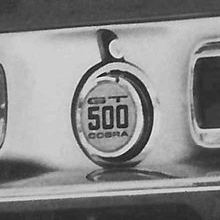
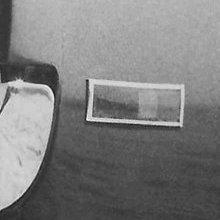
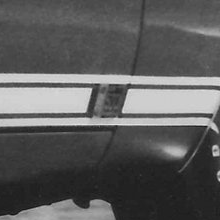
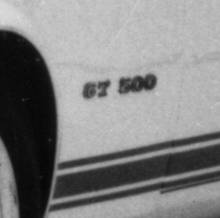
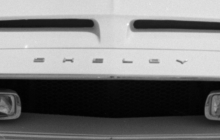
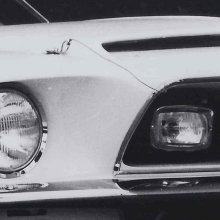
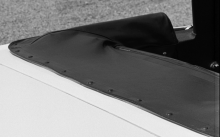
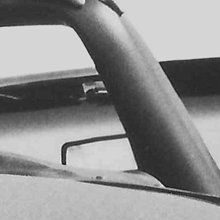
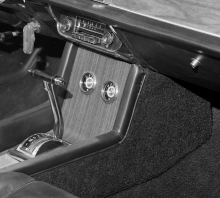
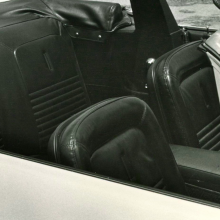
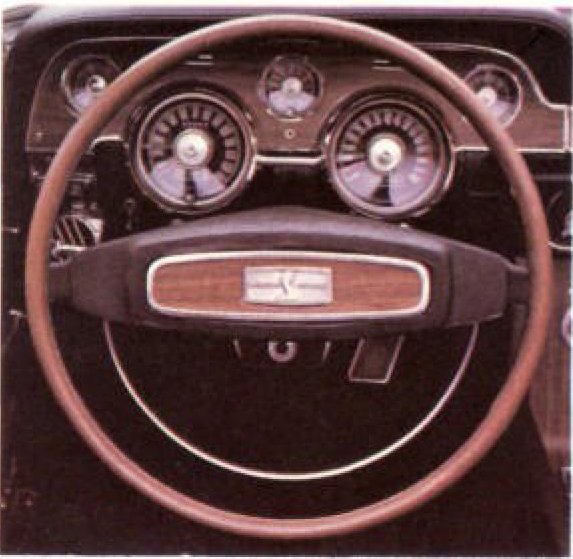
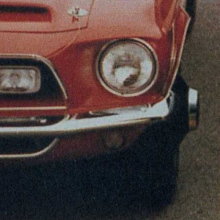 |
Version 1.5 (May/June 1967)
-
Convertible has been repainted Wimbledon White.
Clear evidence of a hasty repaint includes painted bumper
support arms, painted body pinch-welds (both were
originally black), and runs in the paint on the cowl
(visible in the one
engine bay photograph we've found).
- All other
features, including the emblem and stripe treatment,
remain unchanged from V1.
Version
1.5 of the convertible '68 styling car was
photographed by the staff
on the tarmac
outside the LAX facility and
then taken to the
Hollywood Park horse racing track
along with the Acapulco Blue Fastback for a
professional photo shoot.
|
|
 |
Version 2 (July 1967)
-
DZUS
hood locks with cables attaching them to inside
openings of hood scoop replaced the click-pin
locks that had lanyards anchored in grille
opening.
- Quarter panels now
appear to have early ‘68-style reflectors, though
the quarter panel has not been cut or stamped with a recess. The mock-up reflectors in v2 are
surface-mount only.
-
Fuel filler cap
emblem has been updated.
-
Fender emblems
appear very close to production, though they are
actually two separately cast pieces. The snake piece is
thicker and the rectangular
“COBRA” portion has black lettering on a silver
background with red and blue stripes above and
below (a theme shared with the 427 Cobra's side
emblem).
-
Rocker stripes are near production (though still
‘67 style - door justified model rather than
centered like production ‘68).
- Dashboard emblem is now similar to ‘68
production style.
-
Roll-bar and interior panels are updated - both
appear to be molded fiberglass with a spray-on textured
coating. Roll-bar no longer has top clasps.
-
Convertible remains Wimbledon White.
- Body
pinch-welds have been blacked out, however,
bumper support arms are still covered in white
overspray.
- Back
of hood scoop is now accented with what
appears to be black vinyl tape. In at least
one photo is appears that there may have been
covered holes for experimental turn signal indicators on the
rear of the hood scoop.
-
Under
the hood, the factory dual-quad setup has been
replaced with the setup from a 427 Cobra
(intake, 715 CFM 4bbl carburetor and circular
chrome air cleaner).
Version 2 of the '68 photographic (advertising) cars were first photographed during 'press day' at the LLTC held
at
Riverside Raceway on July 7, 1967. Three days
later on July 10th the cars were taken out and photographed
in Idyllwild (California Mountains).
- At
some point soon after the LLTC event, #0463's
radio antenna was relocated from the front right
fender to the left rear quarter. This can be
seen in the '68 Shelby TV commercial.
Note: Six
items, including the updating of the seats, interior trim,
roll-bar, emblems, wheel cover centers and top boot are
mentioned on the handwritten Ionia documents -
Jobs yet to be completed in California,
items 4A-4F.
|
|
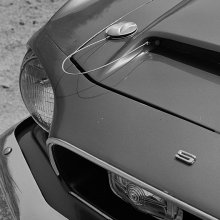
%20220x220.png)

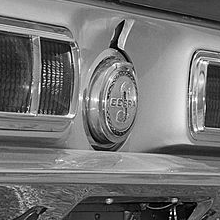
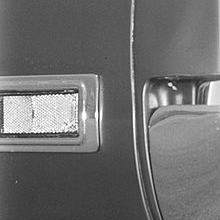
|
The
"1968 Shelby Advertising Cars
Quick Identification Guide"
How to quickly identify the V1-V2 ‘68
advertising cars in old photos:
-
Convertible is painted Candyapple Red or
Wimbledon White
-
Wheels -- when wearing wheel covers, the
paint is inverted from production
colors. Centers also have a
pre-production emblem of a rectangular checkered
pattern behind a left-facing Cobra
snake.
-
Model designation in side stripe is
door-justified like a '67, not centered
on the front fender as the '68
production cars would be.
-
No bright-work on rocker panels.
-
Cables on hood locks -- either
click-pins with cables attached to front
grille opening -or- DZUS locks with
cables attached to inside of hood scoop
openings.
-
Front-mount antenna.
-
Non-production emblems on sides, glove box and
fuel filler cap. Often, the early color
photographs found were often retouched
(airbrushed, altered) to make the car appear as if
it had production emblems and stripes.
-
No embossed emblem on top of center
console armrest.
-
Front seats and console armrest may show
clear signs that they are leather (convertible only).
|
|